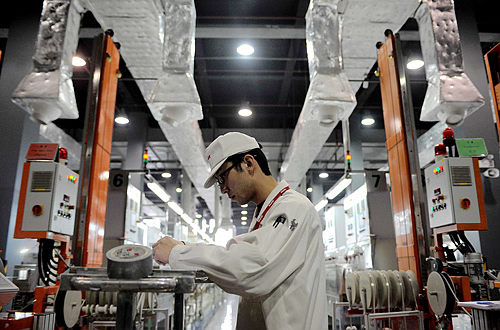| Looking for a new model | |||
|
|||
The State Council issued guidelines on industrial transfers from the east to the west in September 2010. The central and western regions should develop their own advantageous industries individually, said the guideline. In a bid to shake up investment in west China, the guideline set a basic principle for the western region to follow, namely, adjusting measures to local situations and enhancing guidance and administration. To improve the investment environment in central and west regions the government will provide policy support through tax incentives, land use and financing, said the guideline. Experts and scholars say, fostering new growth points is the most important key to solving blind construction and investment. The 11 years following the launch of the western development strategy have shown optimized inter-regional economic planning is the most vital part of promoting balanced economic development among regions and bridging regional gaps, said Chen Zongxing, Vice Chairman of the 11th National Committee of the Chinese People's Political Consultative Conference. The Chengdu-Chongqing Economic Zone, Guanzhong-Tianshui Economic Zone and Guangxi Beibu Bay Economic Zone became the strategic pillars propelling the development of China's west, said Chen. "In the future, we should create more economic growth belts and areas according to the natural conditions and resources. For example, the Lanzhou-Xining-Golmud Economic Zone, Shaanxi-Gansu-Ningxia Economic Zone will become the new growth belt," said Chen. Chen also suggested launching green economy pilot projects in some cities with rich resources, like Qaidam Basin in Qinghai Province, Erdos in Inner Mongolia and Liupanshui in Guizhou. Environmental priority West China, characterized by its highly vulnerable ecosystem, is faced with the dilemma of driving economic growth but not at the cost of environmental damage, a problem the east was not able to solve. West China should not follow the east's path of "pollution first, treatment later," said Wang. Most of the industries transferred from east to west were labor-intensive, high energy-consuming and high-emission producing, a report in the Beijing-based China Environment News said. Jiangxi Province has warmly welcomed the textile, plastic and shoe industries, reported the China Environment News citing the Jiangxi Provincial Commission of Industry and Information Technology. Western cities even invited backward and outdated industries from the east. While eastern Zhejiang Province was regulating its highly polluting lead-acid battery industry, central and western provinces offered favorable policies to invite the poisonous producer. The phenomenon of the west gobbling up the east's unwanted leftover industries is becoming a hazardous trend, said Zhu Hongren, chief engineers and spokesman for the MIIT. The Ministry of Environmental Protection reported in 2005 the serious pollution in Shaanxi, Shanxi and Inner Mongolia was a result of heavy industries that manufactured coking coal, cement and carbide. A World Bank report issued in 2007 showed China's pollution cost about 5.8 percent of GDP each year. The west pays much higher environmental costs from pollution because of its vulnerable ecology, said Shi Minjun, a researcher with the Management School of the Chinese Academy of Sciences. Once the west is polluted, its severity will exceed pollution in other parts of the country because of its upstream location along important water systems, said the China Environment News report. The country issued the Catalog of the Advantage Industries of Foreign Investment in Central and Western Regions in 2004 and its amended version in 2008. Foreign investors will be encouraged to invest in labor-intensive industries that meet the requirements of environment protection in central and western regions. The catalogue was compiled to prevent highly polluting and energy-consuming industries and backward production technology from moving from the east to the west, said the report. The guideline issued in September 2010 also said the government at various levels should screen potential investors in the region. Attracting investment is not mandatory for local business-promoting departments and vicious competition among regions is strictly prohibited, said the guideline. Industrial investment in central and western regions must be in line with ecological factors and backward industries are banned from setting up operations in central and western regions. The environmental impact assessment should be implemented when receiving industrial transfers and environmental monitoring should be enhanced during the process, said the guideline. Although the country issued the guideline to curb high-polluting industries, containing the momentum of pollution-heavy industrial transfers is unlikely, said the China Environment News. What the country really needs is a separate law to prohibit polluting industries in west China. |
| Tools: Save | Print | E-mail |
|
| Comment |





